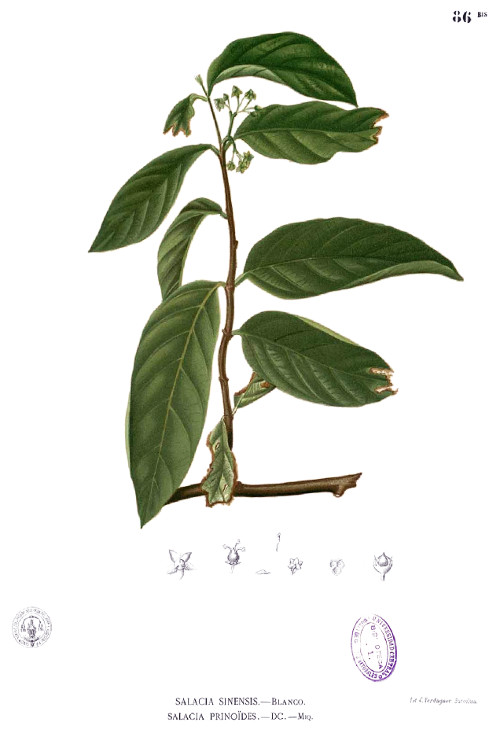Salacia chinensis L. - syn.Salacia prinoides (Willd.)DC.; Tontelea prinoides Willd. - Celastraceae
五层龙 wu ceng long (chin.)
Climbing shrub, to 4m tall, native to Southeast Asia; leaves elliptic to (ob)ovate, leathery; flowers tiny; fruit a globose red berry. „The roots of this species have medicinal uses, including normalizing menstruation and invigorating circulation.“
http://www.efloras.org/florataxon.aspx?flora_id=2&taxon_id=220011886
A potent alpha-glucosidase inhibitor, salacinol, was isolated from the stems of S.chinensis of eleven samples collected in Thailand.
[Biological activities of Salacia chinensis originating in Thailand: the quality evaluation guided by alpha-glucosidase inhibitory activity., Yoshikawa, M., Pongpiriyadacha, Y., Kishi, A., Kageura, T., Wang, T., Morikawa, T., Matsuda, H., Yakugaku zasshi: Journal of the Pharmaceutical Society of Japan, Vol.123(10), 2003, 871-880]
The methanolic root extract contains mangiferin, which acts antidiabetic: „… mangiferin treated diabetic rats
significantly decreased the level of blood glucose, glycosylated hemoglobin as well as increased level of insulin and hemoglobin… The antidiabetic effect of mangiferin was compared with standard antidiabetic drug glibenclamide… The oral glucose tolerance test showed that the mangiferin gave definite lower blood glucose level at the end of 60 min after glucose loaded and even lower level at end of 120 min. The mangiferin enhanced glucose utilization, so the blood glucose level was significantly decreased in glucose-loaded rats.“
[Antihyperglycemic effect of mangiferin in streptozotocin induced diabetic rats., Sellamuthu, P.S., Muniappan, B.P., Perumal, S.M., Kandasamy, M., Journal of Health science, Vol.55(2), 2009, 206-214]
http://jhs.pharm.or.jp/data/55%282%29/55_206.pdf
„Three species of Salacia i.e. S.chinensis, S. reticulate, S. oblonga are used traditionally in Ayurveda, Unani
systems as antidiabetic agent. Preclinical research and isolated clinical trials studying these effects have been promising. Fruits & Roots are the useful parts. Ripe fruits are eaten. Roots have been used as an antidiabetic drug. Salacia chinensis have been used in India and in other countries as a tonic, blood purifier and to treat amenorrhea and dysmenorrhea. Its root bark was used in gonorrhoea, rheumatism and skin diseases.“
[Phytopharmacological aspects of Salacia chinensis., Deokate, U.A., Khadabadi, S.S., J Pharmacog Phyto, Vol.4(1), 2012, 1-5]
http://www.pharmacophorejournal.com/May-June2012-article1.pdf

Blanco, M., Flora de Filipinas, t.86bis (1875)
http://plantgenera.org/species.php?id_species=898563
